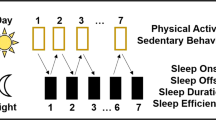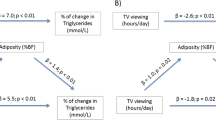Abstract
Sedentary behavior and sleep may be working in concert to increase the likelihood of a child becoming overweight, but in paradoxical ways. Reduction of sedentary behavior (that is, media screen time) has been extensively researched and touted as an intervention target. Inadequate sleep as a putative risk factor for obesity is only beginning to be explored. In this paper, we review the current state of research regarding these factors, and describe the existing evidence and mechanisms proposed to explain these relationships. Whereas the association between weight and sedentary behavior has been consistently shown in observational studies, effect sizes are small, and multiple mechanisms appear to be operating. Recent cross-sectional and longitudinal evidence suggests a link between short sleep duration and weight. Possible mechanisms here include direct metabolic effects as well as indirect behavioral pathways, including the presence of electronic media in children's bedrooms. Measurement issues present a challenge to both areas of research. Prospective studies that include more accurate measures of both sedentary behavior and of sleep will be needed to clarify causal pathways.
This is a preview of subscription content, access via your institution
Access options
Subscribe to this journal
Receive 12 print issues and online access
$259.00 per year
only $21.58 per issue
Buy this article
- Purchase on Springer Link
- Instant access to full article PDF
Prices may be subject to local taxes which are calculated during checkout
Similar content being viewed by others
References
Johnson JO, Kominski R, Smith K, Tillman P . Changes in the Lives of Children: 1990–2000. Working Paper #78 Population Division, U.S. Census Bureau: Washington, DC, 2005, [www.census.gov].
Roberts DF, Foehr UG, Rideout V . Generation M: Media in the Lives of 8–18 Year-olds. Report #7251 Kaiser Family Foundation: Menlo Park, CA, 2005, [www.kff.org].
National Sleep Foundation. 2004 Sleep in America Poll. National Sleep Foundation: Washington, DC, 2004, [www.sleepfoundation.org].
National Sleep Foundation. 2006 Sleep in America Poll. National Sleep Foundation: Washington, DC, 2006, [www.sleepfoundation.org].
US Department of Health and Human Services, Centers for Disease Control and Prevention. Childhood overweight contributing factors. http://www.cdc.gov/nccdphp/dnpa/obesity/childhood/contributing_factors.htm 2005.
Sherry B . Food behaviors and other strategies to prevent and treat pediatric overweight. Int J Obes (Lond) 2005; 29: S116–S126.
Marshall SJ, Gorely T, Biddle SJH . A descriptive epidemiology of screen-based media use in youth: a review and critique. J Adolesc 2006; 29: 333–349.
Anderson SE, Economos CD, Must A . Active play and screen time in US children aged 4 to 11 years in relation to sociodemographic and weight status characteristics: a nationally representative cross-sectional analysis. BMC Public Health 2008; 8: 366.
Canadian Paediatric Society. Impact of media use on children and youth. Paediatr Child Health 2003; 8: 301–306.
American Academy of Pediatrics, Committee on Public Education. Policy statement: children, adolescent and television. Pediatrics 2001; 107: 423–426.
Christakis DA, Ebel BE, Rivara FP, Zimmerman FJ . Television, video and computer game usage in children under 11 years of age. J Pediatr 2004; 145: 652–656.
Vandewater EA, Rideout VJ, Wartella EA, Huang X, Lee JH, Shim M . Digital childhood: electronic media and technology use among infants, toddlers, and preschoolers. Pediatrics 2007; 119: e1006–e1015.
Tremblay MS, Wilms JD . Is the Canadian childhood obesity epidemic related to physical inactivity? Int J Obes Relat Metab Disord 2003; 27: 1100–1105.
Crespo CJ, Smit E, Troiano RP, Bartlett SJ, Macera CA, Anderson RE . Television watching, energy intake, and obesity in US children. Arch Pediatr Adolesc Med 2001; 155: 360–365.
Gortmaker SL, Must A, Sobol AM, Peterson K, Colditz GA, Dietz WH . Television viewing as a cause of increasing obesity among children in the United States, 1986–1990. Arch Pediatr Adolesc Med 1996; 150: 356–362.
Must A, Tybor DJ . Physical activity and sedentary behavior: a review of longitudinal studies of weight and adiposity in youth. Int J Obes (Lond) 2005; 29: S84–S96.
Berkey CS, Rockett HR, Gillman MW, Colditz GA . One-year change in activity and in inactivity among 10- to 15-year-old boys and girls: relationship to change in body mass index. Pediatrics 2003; 111: 836–843.
Reilly JJ, Armstrong J, Dorotsy AR, Emmett PM, Ness A, Rogers I et al. Early life risk factors for obesity in childhood: cohort study. BMJ 2005; 330: 1357.
Cooper TV, Klesges LM, DeBon M, Klesges RC, Shelton ML . An assessment of obese and non obese girls’ metabolic rate during television viewing, reading, and resting. Eat Behav 2006; 7: 105–114.
Dietz W, Bandini LG, Morelli JA, Peers KF, Ching PL . Effect of sedentary activities on resting metabolic rate. Am J Clin Nutr 1994; 59: 556–559.
Vandewater EA, Shim M-s, Caplovitz AG . Linking obesity and activity level with children's television and video game use. J Adolesc 2004; 27: 71–85.
Vandewater EA, Huang X . Parental weight status as a moderator of the relationship between television viewing and childhood overweight. Arch Pediatr Adolesc Med 2006; 160: 425–431.
Robinson TN . Reducing children's television viewing to prevent obesity: a randomized controlled trial. JAMA 1999; 282: 1561–1567.
Matheson DM, Killen JD, Wang Y, Varady A, Robinson TN . Children's food consumption during television viewing. Am J Clin Nutr 2004; 79: 1088–1094.
Bellissimo N, Pencharz PB, Thomas SG, Anderson GH . Effect of television viewing at mealtime on food intake after a glucose preload in boys. Pediatr Res 2007; 61: 745–749.
Halford JC, Boyland EJ, Hughes G, Oliveira LP, Dovey TM . Beyond-brand effect of television (TV) food advertisement/commercials on caloric intake and food choice of 5–7 year-old children. Appetite 2007; 49: 263–267.
Francis LA, Birch LL . Does eating during television viewing affect preschool children's intake? J Am Diet Assoc 2006; 106: 598–600.
Chamberlain LJ, Want Y, Robinson TN . Does children's screen time predict requests for advertised products? Arch Pediatr Adolesc Med 2006; 160: 363–368.
Epstein LH, Paluch RA, Gordy CC, Dorn J . Decreasing sedentary behaviors in treating pediatric obesity. Arch Pediatr Adolesc Med 2000; 154: 220–226.
Gortmaker SL, Peterson K, Wiecha J, Sobol AM, Dixit S, Fox MK et al. Reducing obesity via a school-based interdisciplinary intervention among youth: planet health. Arch Pediatr Adolesc Med 1999; 153: 409–418.
Bryant M, Lucove J, Evenson K, Marshall S . Measurement of television viewing in children and adolescents: a systematic review. Obes Rev 2007; 8: 197–209.
Lutfiyya MN, Lipsky MS, Wisdom-Behounek J, Inpanbutr-Martinkus M . Is rural residency a risk factor for overweight and obesity for U.S. children? Obesity (Silver Springs) 2007; 15: 2348–2356.
Agras WS, Hammer LD, McNicholas F, Kraemer HC . Risk factors for childhood overweight: a prospective study from birth to 9.5 years. J Pediatr 2004; 145: 20–25.
Sekine M, Yamagami T, Handa K, Saito T, Nanri S, Kawaminami K et al. A dose-response relationship between short sleeping hours and childhood obesity: results of the Yoyama birth cohort study. Child: Care Health Dev 2002; 28: 163–170.
von Kries R, Toschke A, Wurmser H, Sauerwald T, Koletzko B . Reduced risk for overweight and obesity in 5- and 6-y-old children by duration of sleep-a cross-sectional study. Int J Obes Relat Metab Disord 2002; 26: 710–716.
Must A, Bandini LG, Tybor DJ, Phillips S, Naumova E, Dietz W . Activity, inactivity, and screen time in relation to weight and fatness over adolescence in girls. Obesity (Silver Springs) 2007; 15: 1774–1781.
Barradas DT, Fulton JE, Blanck HM, Huhman M . Parental influences on youth television viewing. J Pediatr 2007; 151: 369–373.
Ainsworth BE, Haskell WL, Whitt MC, Irwin ML, Swartz AM, Strath SJ et al. Compendium of physical activities: an update of activity codes and met intensities. Med Sci Sports and Exerc 2000; 32: S498–S516.
Seale J, Conway J . Relationship between overnight energy expenditure and BMR measured in a room-sized calorimeter. Eur J Clin Nutr 1999; 53: 107–111.
Singh M, Drake CL, Roehrs T, Hudgel DW, Roth T . The association between obesity and short sleep duration: a population-based study. J Clin Sleep Med 2005; 1: 357–363.
Hennessey E, Kuder J, Goldberg J, Must A, Sacheck J, Economos C . Sleep duration, general sleep pattern, and overweight in early elementary school children. Obesity (Silver Springs) 2007; 15: A142.
Gaina A, Sekine M, Hamanishi S, Chen X, Wang H, Yamagami T et al. Daytime sleepiness and associated factors in Japanese school children. J Pediatr 2007; 151: 518–522.
Eisenmann J, Ekkekakis P, Holmes M . Sleep duration and overweight among Australian children and adolescents. Acta Paediatr 2006; 95: 956–963.
Mamun AA, Lawlor DA, Cramb S, O'Callaghan M, Williams G, Najman J . Do childhood sleep problems predict obesity in young adulthood? Evidence from a prospective birth cohort study. Am J Epidemiol 2007; 166: 1368–1373.
Lumeng JC, Somashekar D, Appugliese D, Kaciroti N, Corwyn RF, Bradley RH . Shorter sleep duration is associated with increased risk for being overweight at ages 9–12 years. Pediatrics 2007; 120: 1020–1029.
Van Cauter E, Knutson K, Leproult R, Spiegel K . The impact of sleep deprivation on hormones and metabolism. Medscape Neurology & Neurosurgery 2005, http://www.medscape.com/viewarticle/502825.
Spiegel K, Tasali E, Penev P, Van Cauter E . Brief communication: sleep curtailment in healthy young men is associated with decreased leptin levels, elevated ghrelin levels, and increased hunger and appetite. Ann Intern Med 2004; 141: 846–850.
Taheri S, Lin L, Austin D, Young T, Mignot E . Short sleep duration is associated with reduced leptin, elevated ghrelin, and increased body mass index. PLoS Med 2004; 1: e62.
Gupta NK, Mueller WH, Chan W, Meininger JC . Is obesity associated with poor sleep quality in adolescents? Am J Hum Biol 2002; 14: 762–768.
Beebe DW, Lewin D, Zeller M, McCabe M, MacLeod K, Daniels SR et al. Sleep in overweight adolescents: shorter sleep, poorer sleep quality, sleepiness, and sleep-disordered breathing. J Pediatr Psychol 2007; 32: 69–79.
Author information
Authors and Affiliations
Corresponding author
Rights and permissions
About this article
Cite this article
Must, A., Parisi, S. Sedentary behavior and sleep: paradoxical effects in association with childhood obesity. Int J Obes 33 (Suppl 1), S82–S86 (2009). https://doi.org/10.1038/ijo.2009.23
Published:
Issue Date:
DOI: https://doi.org/10.1038/ijo.2009.23
Keywords
This article is cited by
-
A qualitative study on multisector activities to prevent childhood obesity in the municipality of Seinäjoki, Finland
BMC Public Health (2022)
-
Promoting physical activity and health in Hong Kong primary school children through a blended physical literacy intervention: protocol and baseline characteristics of the “Stand+Move” randomized controlled trial
Trials (2021)
-
A longitudinal study of sleep, weight status, and weight-related behaviors: Childhood Obesity Study in China Mega-cities
Pediatric Research (2021)
-
A good beginning: study protocol for a group-randomized trial to investigate the effects of sit-to-stand desks on academic performance and sedentary time in primary education
BMC Public Health (2020)
-
Study protocol for a cluster randomized controlled trial to test “¡Míranos! Look at Us, We Are Healthy!” – an early childhood obesity prevention program
BMC Pediatrics (2019)



